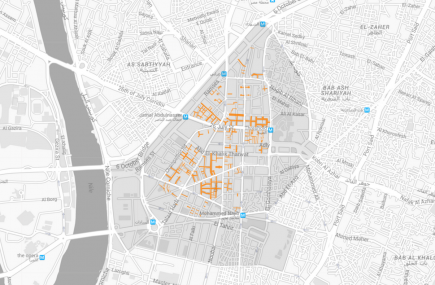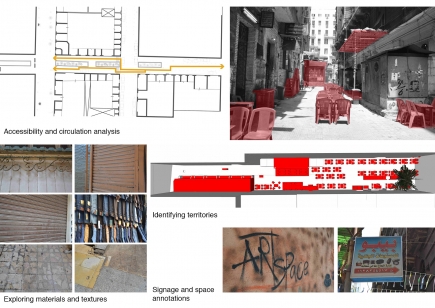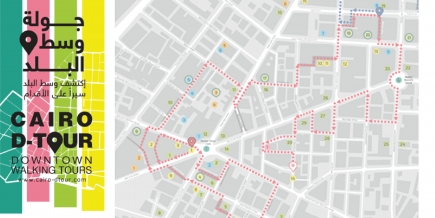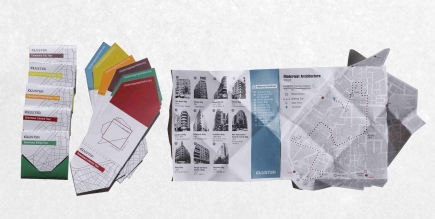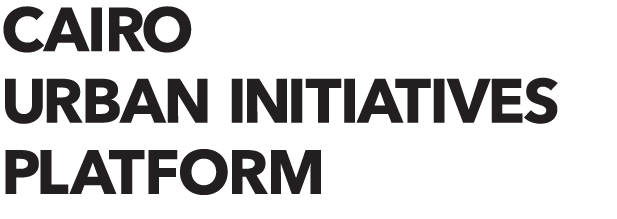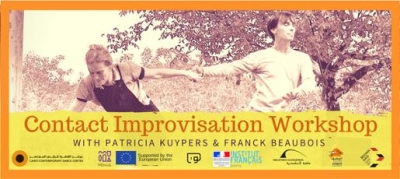| Theme: | |
| Format: | |
| Date: | Sep 26–28, 2017 |
| Organized by: | Cairo Contemporary Dance Center, CCDC |
| Venue: | Cairo Contemporary Dance Center, CCDC |
| Address: | 1 Midan Moussa Galal, off Hijaz St., Mohandessin, 2nd floor. Apt.3 |
| Admission: | Free event |
| Website: | https://www.facebook.com/events/126192864689252/ |
Exclusive Contact Improvisation workshop open to professional and non-professional dancers!
In the framework of MInnA - Egypt (Supported by the European Union), in partnership with Ricerca e Cooperazione, Nout (Alexandria), Embassy of Belgium in Cairo, Institut Français d'Egypte, Bibliotheca Alexandrina and Orient Productions, the Cairo Contemporary Dance Center is hosting an exclusive Contact Improvisation workshop with Patricia Kuypers (Belgium) and Franck Beaubois (France). The workshop proposition was innitiated by Florence Moutin, in an atempt to bring the art of Contact Improvisation to the attention of the Egyptian audience.
This intensive 3-day workshop is open to 5 professional or non-professional dancers with experience - apply now by sending your name, contact information, and previous experiences to:
info@cairocontemporarydancecenter.com
and we will review all the CV's and then will send a confirmation email to the selected 5 only.
Deadline: Sunday 10 September
Priority will be given to participants from Upper Egypt (commuting and per diem costs for 1 participant from Upper Egypt will be covered)
Women performers are highly encouraged to apply
Please note that this is a very physical practice, people should have no recent injury to be able to follow it.
Dates and times:
26-27-28 September 2017, from 10 am to 3 pm
Location:
Cairo Contemporary Dance Center مركز الرقص المعاصر
goo.gl/9JJZSr
Price:
Free of charge
A workshop will also be held at Rezodanse in Alexandria on the 5-6-7 October 2017. To apply for Alex workshop, please visit Centre Rézodanse Egypte Facebook page. Candidates can be admitted only to one of the two workshops.
---
Held by Patricia Kuypers and Franck Beaubois, this workshop offers an introduction to the practice of Contact Improvisation and its main principles.
Contact Improvisation responds to aspirations of change and training and gathers a wide artistic community (dancers, actors, singers, musicians…) around this dance which, in itself, implies collectivity.
Improvisation in the general sense, and particularly Contact Improvisation, put forward open learning, and center on the ideas of analysis and process. The dance also emphasizes the notions of body sensitivity (senses, perceptions), relation to the other (interrelation, interaction), and undetermined collective creation.
Contact Improvisation in a few words
Contact Improvisation (CI) or contact dancing, is a form of improvised dancing characteristic of the postmodern dance movement which developed in the United States during the 1970s. The dance was notably brought to life by the innovations of Steve Paxton and Nancy Stark Smith, born from aesthetical, ethical, artistic and political reflection.
This practice, which centers on one’s relation to the other, brings into play the physical contact points between two or more partners. It thus mobilizes all senses and perceptions (tactile, visual, auditory, kinesthetic…), as well as one’s relation to the environment (the ground, space, gravity…) and to the present moment (what is created in the present instant).
Thus contact improvisation probes the body’s capacity for adaptation in situations of support and of contact, by playing with gravity and with the relation between the dancers. Therefore, “giving-receiving weight” is central to the practice of Contact Improvisation.
This practice requires availability, attention, connection to the senses, and constant adaptation. The dance that emerges from this practice is comparable to a physical dialogue, built on continuous and reciprocate implication, mutual incitement, steady interaction throughout the process, and aesthetic relation.
Instructors’ CVs
Patricia Kuypers (Belgium) is a key player in the transmission and development of Contact Improvisation in Europe. Trained among imminent choreographers and Postmodern Dance innovators (Steve Paxton, Lisa Nelson, Trisha Brown), Patricia is a performer and an outstanding choreographer with a wide and varied repertoire of artistic collaborations (dancers, musicians, plastic artists, improvisers of all sorts, video artists) in the field of improvisation - and all her creations have gained international exposure.
Aside from being a unique choreographer and performer, Patricia Kuypers is also the author of a colossal repertoire of theoretical works of reference in the field of dance. Her works on the practice of improvisation as a form of live creation are notably gathered under the title La Partition Interieure (The Internal Partition) - a collection of texts, dancing conferences, and performances. She is also the founder of the Contredanse association (a center of documentation and information on dance, located in Brussels), where she worked as an artistic director for 20 years; as well as her work as an editor for the Nouvelles De Danse publication.
Patricia is also an excellent Contact Improvisation and improvisation instructor. Her teaching skills are regularly solicited in France and in Europe. She also founded Re-sources, a beautiful practice and training space in Auvergne.
Franck Beaubois (France) is a talented improvisation dancer, and a Contact Improvisation and improvisation instructor. A visual artist by training, he was trained in dancing alongside some of the great names in improvisation and in Contact Improvisation (Katie Duck, Julyen Hamilton, Simone Forti, Lisa Nelson, Steve Paxton, Nancy Stark Smith, Ray Chung…).
An excellent instructor, he teaches in numerous schools and training centers. He is developing a dancing approach specifically catered to the needs of autistic children.
He has been collaborating with Patricia Kuypers for ten years, as a performer in her creations and dancing conferences.
Trained in visual programming by programming artist Michael Egger, he creates ingenious interactive facilities, and uses the video medium to explore the dance movement, which allows him to create live music and lighting from the technical board


